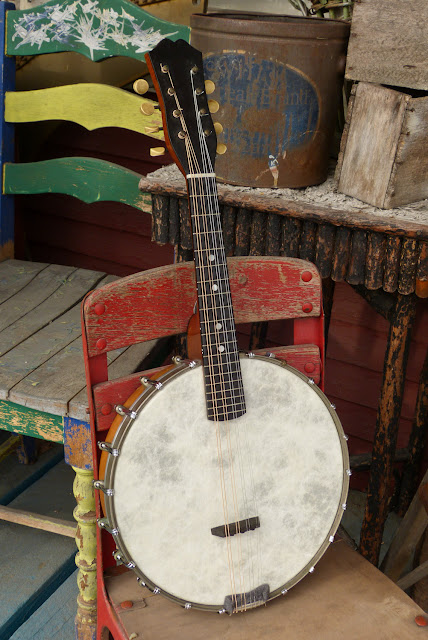1920s Vega-made Unmarked Openback Banjo Mandolin
This is a strange one! It's unmarked but the design is clearly, to my eyes, from the Vega company out of Boston. The rim is severely plain but the same dimensions as a Style K banjo mandolin while the neck materials (mahogany/ebony) and style are also like a Style K but share the rear "volute" and heel cap seen on fancier Vegas like the Little Wonder jo-mandos. It also has a "Little Wonder" skirted-toop tonering, as opposed to the non-tonering Style Ks.
It also has a feature on the tension hoop (which can't be seen in the pictures, unfortunately) that mark it as a typical Vega-make jo-mando -- two holes that would've held rivets to hold the original tailpiece directly on the tension hoop itself. The "actually" strange bits come with it being unmarked, having a curious, "rounded" fretboard extension, and unmatched finish between the neck and rim (although I've seen that before, too, on one Style K and several downmarket 1910s 5-string Vegas).
I worked on this one for a customer and it got a fret level/dress, new bridge and nut, side dots, and a number of modifications to make it a stable, solid performer. It came to me with the replaced FiberSkyn head and modern hook/nut set. It's now playing spot-on with 1/16" action at the 12th fret and strung with 32w-9 GHS A240 strings.
The headstock veneer, fretboard, and heel cap are ebony.
My new bridge is ebony and compensated. I didn't want to cut feet in it so it'd be a bit more stable on the top, so I kept weight down by keeping the overall length about the same as a "normal" two-foot bridge. The foam pad is for muting the extra string length (which would otherwise make a banjo-mandolin unlistenable from all the overtone saturation).
Here's the "volute" at the back of the headstock. The tuners are also the same type as found on the entry-level Style Ks as opposed the Waverly units used on most Vegas.
The foam pad helps to mute overtones (something painfully abundant on banjo-mandos of all stripes) and keeps the sound more fundamental.
The hammer-in, screw-tight neck brace is "original" -- more or less -- but needed a replacement set-screw. I also made it redundant because I shored-up the neck joint with a bolt/screw instead as I find neck-braces like this impractical. See below...
...how that countersunk screw will hold that neck "pat" far-better than any neck brace will. I've grown frustrated with even bothering to setup a banjo mandolin, these days, until I'm sure the joint itself is rock-solid and not held in place by, essentially, only a friction-tightened wedge. Banjo-mandolins are finicky enough without having to deal with the possibility of the joint getting loose while moving them from here to there and bumping them about.
The tailpiece that came with this (also a Waverly unit missing its cover) was secured via an endbolt and aligned terribly with the neck. I decided to use a screw to hold the dowel in place and forego the endbolt. I then scrounged this non-banjo-modified tailpiece from my parts-bins (same era) and secured it a hair over and aligned with the neck correctly. It's not beautiful but it's very functional and sturdy.
















Comments